25 November, 2003
A Day in the Life of a Valley Girl
Don’t worry, I haven’t started donning purple eye shadow or using phrases
like “Oh, my God!” or “Gag me with a spoon!” For unlike Moon Unit Zappa,
I’m a totally different kind of Valley Girl. Here’s a description of a day
in the life of an Antarctic Valley Girl.
7:00am- my alarm watch goes off. Is it really time to get up? It’s so
snuggly inside my sleeping bag. I think I could stay here forever.
7:30am- I finally get the courage to get out the bag and get dressed.
Hmmm… this seems fairly clean, well at least cleaner than the others…
7:45am- I’m FINALLY dressed (it’s a lot more clothes than I’m used to
putting on) and I craw out of the tent and head into to the James Way.
Water is heated on our gas stove to make oatmeal. I have a quick bite of
oatmeal, a cup of coffee or tea, and eat a little beef jerky.
8:00am- I begin making my lunch and packing my pack. Do I have all the
sample bags? Do I have my pee bottle? Who’s going to carry the thermos of
hot water? Do I have enough snacks and water? The longer the hike, the
more we need.
8:30- Brush my teeth, put on my boots, and lather on the sunscreen and lip
balm (remember, the sun is always up in Antarctica this time of year!) .
8:45am- Do yesterday’s dishes that have been soaking in the tub (That is,
if Dr. Connell hasn’t already done them. She’s an early riser too.) We
have to monitor our gray water production, so we wash our dishes with very
little water.
9-9:30- Last minute trip to the latrine and take care of any other needed
tasks.
9:45am- Rusty treks across the ice to start the ATV. (It takes a bit to
warm up in the cold weather). We put on our remaining clothes (neck
gaters, gloves, hats, and jacket) and put on our packs. We all pile on the
ATV (Rusty and Regina facing forward and Laurie and I in the back) and
Rusty drives us across the ice to the opposite end of the lake.
10-10:30- we are finally ready to hike to our first sampling site.
Our hikes average about 6-7 hours. Some days were short trips (only about
three hours), while others were longer. Today’s trip was a long one
(almost 10 hours). Since we are sampling along transects throughout the
valley, we are often hiking up and down steep surfaces. The soil is very
rocky and one has to be careful that they do not fall, or twist an ankle.
Since this Florida girl is used to very flat surfaces, this took a little
getting used to. While going up is physically harder, going down makes me
a little nervous. I just take my time and am starting to get a handle on
it. I must admit, I did a lot of slipping my first day out.
It is important that we eat throughout the hike, so we take a lot of
breaks. About every hour or two we stop for a quick bite to eat and drink.
Snacks include dried fruits, cabin bread, cheese, beef jerky, and
chocolate bars. Not being a huge chocolate eater, I have now grown to
appreciate the quick energy of chocolate bars and always make sure I’ve
eaten at least a little before approaching a big ascending incline.
Unfortunately, when we stop walking, we tend to get cold. Therefore, our
food breaks usually last no longer than 10-15 minutes. Depending on the
day, we will collect samples from anywhere between two and four sampling
sites. If we take three samples from each location, what is the average
number of samples collected on a parcticular day?
The scenery in the Dry Valleys makes for a beautiful hike. Unfortunately,
I have to make a point to stop and look around, as I am often paying such
close attention to the ground when I am walking. In the beginning, Dr.
Connell was actually reminding me to stop and take pictures. Now that I’ve
become more comfortable with the routine, I can more easily hike, quickly
take out the camera, and continue on my way.
I’ve been surprised at what little clothing we actually wear during our
hikes. Our big red parka is too warm, so we wear our issued wind jacket.
We usually start wearing our fleece layers over top of our long johns, but
usually quickly remove the fleece top after hiking for about fifteen
minutes. Yes, you do sweat in Antarctica! The same is true with our
gloves. While hiking we usually only wear our glove liners. We only tend
to get cold when we stop moving. Like during our food breaks, we play the
thermoregulation game when stopping to sample. (Clothes on clothes off…)
Although we have to drink a lot of water on our hikes due to the dry air,
we loose water through our physical activity. Thankfully this means my
urine output is much lower than I thought it would be and I rarely have to
use my pee bottle!
5-6:00- We return to camp and place our samples on ice. Rusty tends to
some of the needed chores (chipping ice for water, gathering fuel for the
generator, or latrine duty). Thank you Rusty!!! I usually try to get a
head start on labeling the sampling bags needed for each location
(Remember, we need six bags for each site) and Regina begins cooking.
6:30-7:00- Dinner. At Lake Fryxell, we have access to a stove and have the
capability of cooking a hot meal. Regina has been feeding us scrumptious
meals all week: steaks, curry chicken, and scallops over noodles. What
doesn’t get eaten will often become tomorrow’s breakfast. It is amazing
how good food tastes after a day out in the field and she is an excellent
chef. Thank you, Regina!
7:30/8:00- In order to make it seem like night, we close the curtains in
the James Way. A few games of Kings in the Corner, great conversations, or
a good book make for a great evening. For a real treat, we’ll pop in a DVD
into one of our laptops and make it movie night. We can’t do this too
often as our computer batteries will run down and we are only to run the
generator for necessary tasks, such as charging our hand-held radios.
10:00pm- It’s time to hit the sack. The bright light and cold air is a
rude awakening as we leave the James Way and head to our tents. I change
into my sleep clothes (a separate pair of long johns and a warm up suit-
which at least make me feel a little cleaner) and craw into my bag. I try
to write a little in my journal or read a bit of my book, but in a matter
of only a few minutes I find myself falling right to sleep. Even though
the sun is shining through the night, I sleep quite well in my cozy tittle
tent.

1. A view of our home at Lake Fryxell
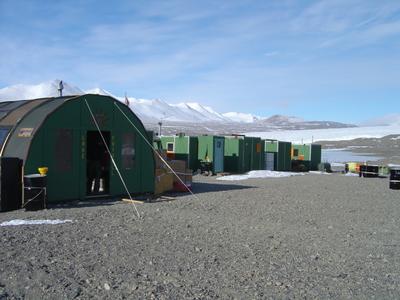
2. A back view of the camp. From left to right are the James Way and misc. labs and sheds. The latrine is the one with the white door. The barrel close to the James Way is the barrel in which we pour our gray water. The barrels you see attached together contain things like fuel for the generators or used gray water.

3. My cozy little tent. Why does this little tent keep me warmer than a bigger one?
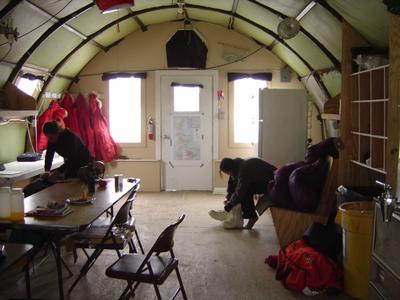
4. Inside the James Way- The entry, “living room”, and dining area.
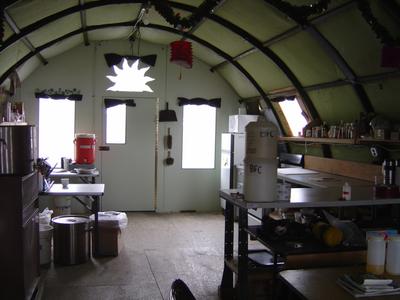
5. Inside the James Way- The Galley. Isn’t the sun carving great?

6. Dr. Rusty Rodriguez had just come back from chipping lake ice for our drinking water. This ice will be melted and then run through a filter. Why should we filter our water? You can also see our ATV on the lake ice.

15. Here’s the route we took for our longest hike. We were gone 10 hours and covered well over 12 miles.

8. Lunch break. Lunch usually consists of a cold cut wrap and hot soup. It’s very quick and extremely yummy.
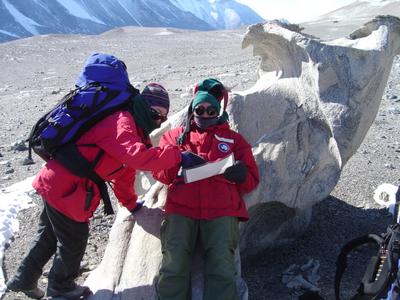
9. We have specific locations from which we need to sample. Here Laurie shows Rusty the location of our next sampling site on our map of the Taylor Valley.

10. Although we are here to do work, we still have a good time. Here Dr. Rodriguez is enjoying his view from the top of a ventifact. The valleys have a lot of these rocks that were carved out over time by the wind.

11. Throughout our hikes we are amazed at the place in which we are working. The views are absolutely incredible! The Suess Glacier, located on the other side of the valley, is behind me.
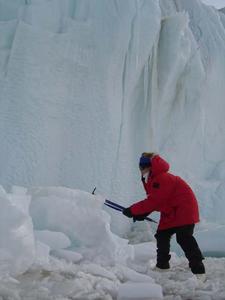
12. Here I am chipping ice from the Canada Glacier for “glacier berries”.
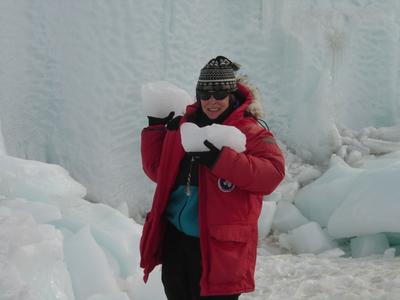
13. Dr. Laurie Connell with sample “glacier berries”. We will put them in a banana sled that sits just outside the James Way. This will keep our samples cool enough until we can return from camp. Why must we keep them on ice?

14. Me on Lake Fryxell standing near the Canada Glacier. I think this picture shows how big this thing really is. Soon we will not be able to get this close to the glacier. Why not? (Hint: what is happening to the ice this time of year?)
Contact the TEA in the field at
.
If you cannot connect through your browser, copy the
TEA's e-mail address in the "To:" line of
your favorite e-mail package.
|
